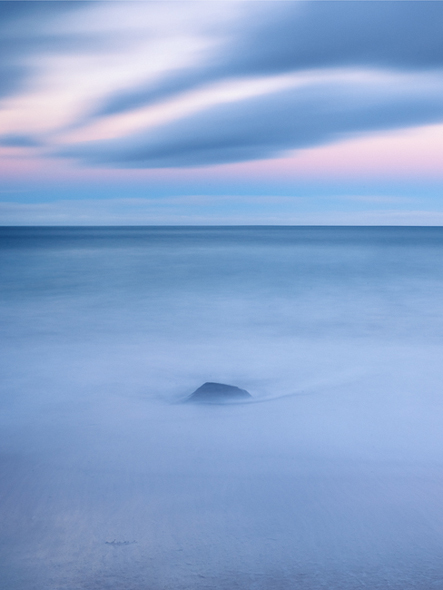Continued from here (Part I) and here (Part II).
I would definitely use a better weather when shooting Phase One IQ250. I only had couple of days on Isle of Harris with this chubby baby. Not enough. The very most of time spent either drying it or admiring its design. Or, testing the wi-fi connected to my iPad and Capture Pilot app. This is by the way a lovely feature. You can preview the photos on iPad's screen, which can prove helpful when a) you have a lot of time that we landscapers usually do; b) you know you are about to create a masterpiece; c) you shoot technical camera hence need to check the focus. I would want all three conditions to be met at the same time to use this feature. As you may look awkward when doing so out in the field.
Tribute to Ota for this action-packed rainy image of me and IQ250.
Back to the weather now. It rained for the most of time. The robust build of the IQ250 enjoyed a proper testing of its weatherproofness. Ota and I cursed somewhat more than usually. In the car while waiting for our chances. Which we got because we are patient during our vacation, but as you can imagine, the lighting conditions were pretty lame as demonstrated above.
Caption: Three Rocks, Camera: Phase One 645DF+, Lens: Schneider-Kreuznach 45mm, Digital Back: Phase One IQ250, ISO: 100, Speed: 39s, Aperture: f/22, Filters: Lee ND Graduated Soft 0.45, Lee ND 0.9
Here I share the secret landscape photography tip: don't wait for a better weather, shoot long exposure. (And yes, you can always convert to black and white if this does not create something out of nothing... ;-) )
In fact, I have been shooting longer exposures on my beloved Fuji Velvias ever since I have started using them. The low ISO of 50 combined with pre-dawn timing of majority of my attempts always results into few seconds of shutter speed, or more. As I liked the unpredictability element of exposing Velvia longer, I equipped myself with Lee Big Stopper to get even slower.
Caption: Buoy and Sky, Camera: Phase One 645DF+, Lens: Schneider-Kreuznach 45mm, Digital Back: Phase One IQ250, ISO: 100, Speed: 1m 11s, Aperture: f/5.6, Filters: Lee ND Graduated 0.6, Lee ND 0.9
Long exposure is what does not work particularly well with IQ140. Images that were exposed for more than 30 seconds show high level of noise even at 50 ISO. You need to call the Wizard of Capture One for help to eliminate it, but it just can't be done for 1+ minutes or higher ISOs (when shooting aurora, for example, where the need is to keep exposure below 20 seconds to avoid the movement of stars). I understand IQ140 was not primarily designed for landscape photographers and I learnt to live with this limitation.
So the weather on Isle of Eigg caused me to see in the greatest extend how Phase One IQ250 deals with a long shutter speed. I fired over 100 frames with over 1 minute exposure. The results are insanely mind-blowing when it comes to the quality of output. I reviewed all raws by now and they are just freaking clean - cleaner than my noise-free long exposure Velvia scans. On top, at 100% enlargement I see that the finest details are retained, even in the darkest shadows. This is what no scanner can get out of any film, but the truth is that's not so important. It is just so exciting to experience the high-end technology that pushes the technical quality of files to the whole new level, certainly couple of floors above from what I have seen so far.
Caption: Hebridean Pastels, Camera: Phase One 645DF+, Lens: Schneider-Kreuznach 45mm, Digital Back: Phase One IQ250, ISO: 100, Speed: 1m 48s, Aperture: f/8, Filters: Lee ND Graduated 0.6, Lee Big Stopper
I mentioned already, there is an amazing amount of colour information captured in every raw file. One needs to be careful not to bring out the craziest hues you can imagine. It was uneasy to stay rather calm and conservative, and try to recall what I remember seeing when firing the trigger. Unlike with film, it is you who sets the direction of post-processing (or rather reconstructing colours), which I still find quite unsettling. I'm making this post more of a showcase of photos that have been processed differently. So enjoy and let me know what you think.
Caption: Hebridean Blues, Camera: Phase One 645DF+, Lens: Schneider-Kreuznach 45mm, Digital Back: Phase One IQ250, ISO: 200, Speed: 1m 57s, Aperture: f/11, Filters: Lee ND Graduated Soft 0.45, Lee Big Stopper
I'm concluding this series here. The bottom line is that Phase One IQ250 is by far the best and the most expensive piece of equipment I ever put my hands on. So the equation works perfectly. We may want to discuss if a price tag justifies the quality edge, but let's not get there. I think it certainly would for some people. Mounted on Linhof Techno, with a digital Rodenstock on, it delivers unbelievable image quality that is razor-sharp and packed with micro details all across the frame. The focussing on technical camera becomes a breeze with IQ250's live view. Add the amazing long exposure and high ISO performance, and you will get the ultimate digital kit for a landscape photographer with an unrestricted budget. Or with an older model of Phase One back as the company tends to make the upgrade deals too sexy to refuse.


